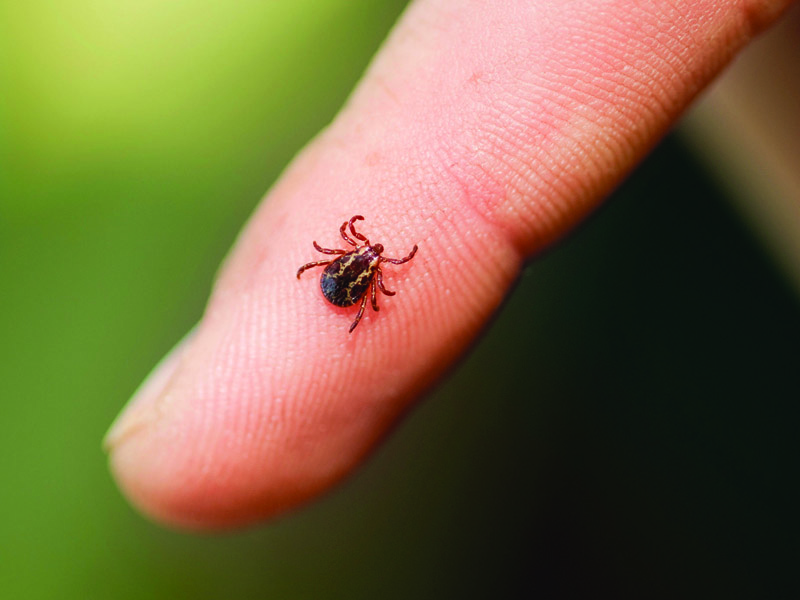Patients and doctors who believe there is a hidden Lyme disease epidemic have become a formidable political force
The medical establishment rarely faces the court of public opinion, and wars over medical truths are largely fought in the pages of esteemed journals. But in the case of Lyme disease in Australia, the dispute between patient advocates and medical authorities has become increasingly public and sour.
There is “no convincing evidence” that Lyme disease can be acquired locally from Australian ticks, a recent article in the MJA states.1 Despite this lack of evidence, thousands of patients with debilitating chronic illness believe they have the disease.
The unfolding drama of the Senate inquiry into Lyme-like illness has further pushed Lyme disease into the limelight, with the latest clash occurring at a public hearing in Sydney in November.
Dr Gary Lum, clinical microbiologist and senior medical officer in the Federal Department of Health, predicts the two camps will remain divided. “Noting (that) verifiable, validated evidence is yet to be found for many aspects of this problem, there will continue to be disagreement,” he told The Medical Republic.
Lyme disease was first recorded in the US in the late 1970s and has since appeared across Europe, Japan and China. The illness is caused by four main species in the bacterial genus Borrelia, namely Borrelia burgdorferi, Borrelia mayonii, Borrelia afzelii and Borrelia garinii.
It is transmitted to humans through the bite of a tick.
But no survey of Australian ticks has ever found they carry these bacteria. Moreover, Borrelia has not been cultured from any individuals who claim to have acquired the disease in Australia.
“Despite a number of reports of putative cases and a discussion across several decades, locally acquired classic Lyme disease has not been identified in Australia,” the authors of the recent MJA article (Dr Lum, and microbiologists Professor Peter Collignon and Dr Jennifer Robson) write.
But Lyme disease advocates contest these facts. “We have [locally acquired] Lyme disease in Australia,” insists Dr Hugh Derham, a GP from Western Australia. “It absolutely exists and it’s common.”
Dr Derham is one of several “Lyme-literate” doctors who have made submissions to the Senate inquiry defending their controversial testing, diagnoses and treatment plans. He claims to have personally diagnosed over 900 patients with Lyme disease. “The only trouble is that nobody will believe it,” he says.
Bolstered by a handful of sympathetic GPs and positive test results from unaccredited laboratories, people who believe there is a hidden Lyme disease epidemic have become a formidable political force in Australia.
Online information sharing and social media has brought thousands of these people together to form lobby groups in most states. The most prominent organisations include the Karl McManus Foundation and the Lyme Disease Association of Australia.
Over the past decade, Lyme disease advocates have become more vocal. It was only a matter of time before the government had to respond. In 2013, the government launched a Clinical Advisory Committee and commissioned a scoping study on Lyme disease.
In 2015, this evolved into a full-blown Senate inquiry titled: “Growing evidence of an emerging tick-borne disease that causes a Lyme-like illness for many Australian patients.” Before releasing its interim report in May 2016, the inquiry received more than 1100 submissions and hosted multiple public hearings across the country.
The Senate Committee interim report tells a story of patients grappling with chronic symptoms, frustrated by medical practitioners who seem to fail to take their illness seriously. “Many submitters have been told that their symptoms were psychological, and that ‘it’s all in your head’,” the report states. Patients expressed feelings of being let down by the healthcare system and said they experienced significant stigma when seeking treatment for what they believe is Lyme disease.
The inquiry also revealed a heavy financial burden on many patients. “In one case, a submitter claims to have spent over $100,000 on treatment since diagnosis,” the report states. Such figures may be overstated, but The Medical Republic did find one GP with an interest in Lyme disease who charges $600 for an initial one-hour appointment. Some patients report paying hundreds of thousands of dollars for Lyme disease testing, the expense often falling on the patient, as tests performed in non-NATA accredited laboratories do not attract a Medicare benefit.

Does chronic Lyme disease even exist?
While it’s acknowledged that classic Lyme disease can progress to late stage disease if untreated, battlelines have been drawn over “chronic Lyme disease”.
Patients with classic Lyme disease typically present with a rash (erythema migrans), fever, headache or facial nerve palsy two to six weeks after being bitten by a tick. Early disseminated symptoms include erythema chronicum migrans rashes, meningitis, cranial nerve palsies and carditis, whereas people with late stage Lyme disease primarily present with arthritis.
Lyme disease can be effectively treated with short-term antibiotics regardless of when it is diagnosed. Even when initially untreated, Lyme disease can be effectively managed months or years later with oral or intravenous doxycycline or cephalexin for around 14 days.
“It generally doesn’t persist after that,” says Dr Jennifer Robson, an infectious disease physician at Sullivan Nicolaides Pathology.
The existence of chronic Lyme disease, however, remains contentious. Advocacy groups, such as the Lyme Disease Association of Australia and the International Lyme and Associated Diseases Society, argue that a range of debilitating symptoms are the result of late stage Borrelia infection, even if treated. These symptoms are said to include fatigue, headache, muscle and joint pains and cognitive impairment.
But the National Institute of Allergy and Infectious Diseases in the US rejects the use of the term “chronic Lyme disease”, as do Australian medical authorities. “In Australia … the experts in microbiology and infectious disease will not readily accept that there is chronic Lyme disease or chronic persistent active infection,” Dr Lum told the Senate inquiry.
If not Borrelia, then what is causing the symptoms in these patients convinced they have Lyme disease? Dr Robson’s best guess is that a number of ailments are being lumped together under the label “chronic Lyme disease”.
“It is very important that these patients with these chronic debilitating symptoms do get other things considered,” she says. GPs are often caught “between a rock and a hard place” when there is no satisfactory medical explanation for a patient’s symptoms. However, labelling patients incorrectly and giving them antibiotics without scientific evidence isn’t helpful, she adds.
Sydney psychiatrist Dr Joseph Dunn offers an alternative explanation. In his own submission to the inquiry, Dr Dunn argues that Lyme disease is the latest in a long list of “medical myths” created to explain illnesses that are actually “somatic symptom syndromes”. Patients with these syndromes suffer genuine and disabling illnesses that are not caused by an external agent. Lyme disease practitioners may take credit for “cures”, but the symptoms simply resolve themselves over time, Dr Dunn contends.
Testing confusion
“I do not have hundreds of patients who believe they have Lyme disease; their belief is founded on good evidence.” That is what Dr Derham told the Senate committee. Each of his diagnoses for Lyme disease has been confirmed by positive test results.
However, these particular tests are fraught with controversy. Australians who contract Lyme disease overseas can have their diagnosis confirmed by culture of Borrelia bacteria in skin or blood, two-tiered serological testing or PCR at a NATA-accredited laboratory. “Every test though, it must be remembered, can produce false positives and false negatives and you’ve always got to put the test result into a clinical context,” says Dr Robson.
However, Dr Derham and like-minded practitioners tend to use overseas laboratories or non-NATA accredited laboratories, such as Australian Biologics. The tests conducted at these facilities differ from those done at accredited laboratories and tend to return positive results. Unlike other Australian accredited laboratories, Australian Biologics uses serological tests for Borrelia imported from Germany. “In some of these other labs, a large percentage of people are coming out as positive,” says Dr Robson. “The tests haven’t been accredited for use in Australia.”
Most Australians who have not travelled overseas do not test positive for Lyme disease when practitioners follow the guidelines outlined by the Australian Department of Health.2
The TGA plans to crack down on aberrant diagnostic testing, Dr Lum says.
From July 2017, all diagnostic tests will be subject to regulation. “Specifically, if a commercially purchased assay is modified by a scientist or pathologist it will become an in-house in vitro diagnostic device and will require assessment under the TGA regulations,” Dr Lum says.
But the real problem, according to Dr Robson, is that many tests for Lyme disease should never be done in the first place. Unless there are explicit symptoms and history, Dr Robson says she generally would not test for Lyme disease. “Without the overseas history you are often asking for trouble and you then start to get false positives and tests that are difficult to interpret,” she says.

Anti-antibiotics
Another debate rages around treatment for what advocates label chronic Lyme disease. The recent MJA article slams the use of long-term antibiotics by some Australian practitioners. “Prolonged intravenous or oral antibiotic therapy is both unjustifiable and unethical, and is likely to do much more harm than good,” the authors write. The article cites four randomised trials for long-term antibiotic treatment for Lyme disease, which all show that it does not improve symptoms.
Not only do long-term antibiotics fail to improve the lives of patients, they can be dangerous. “If you put in a long line to administer antibiotics for weeks then [the patient] is at risk of developing what we call Lyme sepsis,” says Dr Robson.
Staphylococcus aureus infections are associated with intravascular antibiotics. These infections have a high morbidity and mortality rate. “[Patients] are at risk of getting these bacteraemias that can kill you in the worst-case scenario due to endocarditis,” says Dr Robson.
Antibiotic resistance in the community due to the needless use of broad-spectrum antibiotics, such as ceftriaxone, is also a “major problem”, the MJA authors write.
They are not alone. “The advice currently is that long-term treatment with antibiotic therapy can cause harm to the patient and to the community and remains not supported by numerous appropriate clinical studies,” Dr Tony Bartone, GP and vice president of the AMA, told The Medical Republic.
But proponents of this form of therapy swear that it works and tend to brush off the risks. “Of the other 2500 patients we have treated, most are better,” says Dr Richard Schloeffel, a Lyme practitioner in Sydney. He treats patients with oral antibiotics and intravenous antibiotics for long periods of time. Dr Derham points out that long-term antibiotics are viewed as acceptable treatments for acne and tuberculosis.
“Over 50 [of my] patients have indicated that they are prepared to testify to their significant improvement in functioning after appropriate treatment by me,” he says.
Searching for answers
Experts and Lyme disease advocates largely agree that the Lyme disease puzzle will only be solved through further research.
As no evidence for locally acquired Borellia exists in Australia, advocates have begun to use the term “Lyme disease-like illness”. This describes a poorly defined cocktail of pathogens from ticks that can make people sick. The term has no support from authorities.
Confusingly, it has been used to describe both classic and chronic Lyme disease, as well as co-infections and other unknown infections transmitted by ticks. “It is currently not clear if the “Lyme-like illness” is one condition or a collection of different illnesses,” the AMA says.
What is clear is that many people have chronic symptoms they believe are associated with a tick bite. This has raised the suggestion that novel, indigenous pathogens transmitted by Australian ticks are causing disease in humans.
Australian ticks are known to transmit three species of the bacteria Rickettsia, which causes spotted tick typhus in humans. Recent research by a team at Murdoch University in Perth found five previously unknown bacterial species in the genus that cause disease in the northern hemisphere. This includes one new Borrelia species from a tick that bites echidnas and two new species of Neoehrlichia.
“We don’t know whether the Borrelia is pathogenic,” microbiologist Dr Charlotte Oskam, who worked on this project, says.
The team has been able to identify a number of candidates for potential pathogens in a “very short time”, Dr Oskam says. “We’ve got so many unique native wildlife and native ticks,” she continues. “I wouldn’t be surprised if we do find a (new) tick-borne disease that is causing illness when people get bitten by Australian ticks.”
Meanwhile, the Lyme wars will continue to raise tempers.
“The people who are really answerable for all this shemozzle are the infectious diseases physicians and they should be de-registered for incompetence and dishonesty,” says Dr Derham. “You can’t really blame GPs [who don’t recognise locally acquired Lyme disease]. They are being told by experts that black is white.”
References:
1 N Engl J Med 2016; 374:1209-1220.
2 http://www.health.gov.au/internet/main/publishing.nsf/Content/ohp-lyme-disease.htm/$File/Aust-guideline-diagnosis-overseas-acquired-Lyme-disease.pdf


